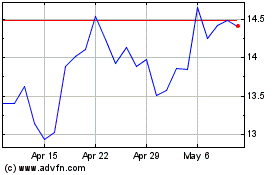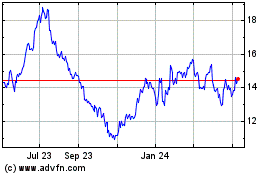Airlines Seek $50 Billion in Government Aid Amid Coronavirus Crisis -- Update
March 16 2020 - 2:38PM
Dow Jones News
By Alison Sider in Chicago and Ted Mann in Washington
U.S. airlines are in talks with the government to obtain at
least $50 billion in financial assistance -- more than three times
the size of the industry's bailout after the Sept. 11 attacks --
according to people briefed on the discussions.
The exact form and amount of aid carriers are seeking is under
discussion, and could include government-backed loans, cash grants
or other measures including relief from taxes and fees, according
to some of the people and a proposal released by an airline trade
group Monday.
Airlines have been stunned by the rapid plunge in their bookings
as the novel coronavirus has spread around the world. As the
worst-case scenarios they envisioned just days or weeks ago have
come to pass, carriers have scrambled to make ever deeper cuts to
their schedules.
United Airlines Holdings Inc. said Sunday night it would cut its
planned flying in half in April and May and is in talks with its
unions about steps that could include furloughs, pay cuts or other
measures to reduce payroll expenses.
Delta Air Lines Inc. and American Airlines Group Inc. have also
announced severe cuts in flying, hiring freezes and voluntary
unpaid leave for employees. All three carriers have disclosed that
they are in talks with the government, but the amount of assistance
being discussed hasn't been previously reported.
Airlines for America, the industry trade group, issued a
proposal Monday for $50 billion in aid that it had circulated
privately in recent days.
The trade group argued that half of the assistance should come
in the form of direct grants to airlines.
The proposal also outlines a $25 billion program in which the
Federal Reserve would purchase financial instruments from, or
provide interest-free loans or loan guarantees to, passenger and
cargo carriers.
It also includes provisions for rebates of excise taxes --
including those on tickets, cargo and fuel -- that airlines paid in
the first quarter and a repeal of those taxes through at least Dec.
31 2021.
But some lobbying on behalf of the airlines believe that figure
might not be enough, given the likelihood that the disruption to
air travel will last for months, leaving carriers with huge debt
loads and depressed cash flows.
"They might be shooting too low," one person involved in the
talks said.
The Trump administration is using the post-Sept. 11 bailout
passed by Congress in 2001 as a template for the talks with
carriers, people involved in the discussions said.
Lawmakers in 2001 made $5 billion in direct payments to airlines
after the terrorist attacks that prompted a three-day closure of
North American airspace. They also earmarked up to $10 billion to
support U.S. airlines through a loan program, though only $1.56
billion in guarantees were authorized, including to carriers that
ended up failing.
"We don't see the airlines failing, but if they get into a cash
crunch we're going to try to help them," National Economic Council
Director Larry Kudlow told reporters at the White House on Monday.
Mr. Kudlow said "lots" of airlines had reached out seeking
assistance.
"We're in touch about their balance sheets and their cash flow,"
he said.
--Andrew Tangel and Doug Cameron contributed to this
article.
Write to Alison Sider at alison.sider@wsj.com and Ted Mann at
ted.mann@wsj.com
(END) Dow Jones Newswires
March 16, 2020 14:23 ET (18:23 GMT)
Copyright (c) 2020 Dow Jones & Company, Inc.
American Airlines (NASDAQ:AAL)
Historical Stock Chart
From Mar 2024 to Apr 2024

American Airlines (NASDAQ:AAL)
Historical Stock Chart
From Apr 2023 to Apr 2024
